
Downtown banks used to be where eager home buyers applied for mortgages, workers cashed hard-earned paychecks, and youngsters watched nickels and dimes grow in their first savings accounts. But in recent decades, ATM machines and online banking have made these once essential institutions obsolete.
Fortunately, developers and businesses across New Jersey have repurposed dozens of downtown banks as office spaces, restaurants and, in at least one case, a vape shop.
For developer Bob Silver, rescuing old banks has become a personal crusade. “I love everything about history, preserving history and rescuing buildings for different purposes,” says Silver. “I’m very environmentally sensitive, and the greenest thing you can do is keep a building in place and repurpose it.”
Silver, the cofounder and chairman of the Bravitas Group, a Montclair development company, has renovated and transformed three classic bank buildings in Montclair and Caldwell and is working on a fourth. His bank jobs pay close attention to preserving the distinctive original features of the buildings, including their impressive façades, high ceilings, walk-in vaults and other architectural details.
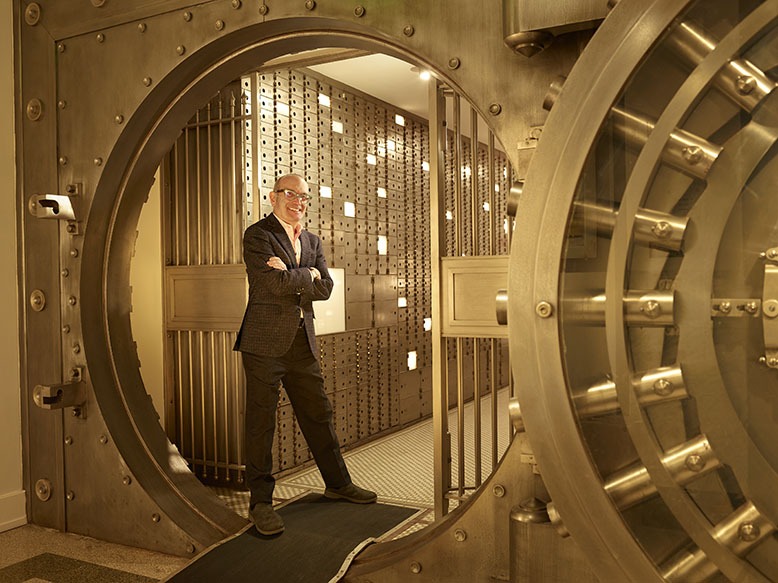
Developer Bob Silver enters the safe-deposit vault that now serves as a hallway in Grover House in downtown Caldwell. Photo by Chris Buck
Bravitas is hardly alone in such endeavors, known among preservationists as adaptive reuse. By saving banks, these developers help maintain the character of downtowns and set a standard for further preservation.
In fact, older bank buildings are ideal candidates for adaptive reuse. David Listokin, a professor at the Edward J. Bloustein School of Planning and Public Policy at Rutgers University, enumerates the reasons that many bank buildings, although aesthetically striking, have become relics. They typically lack drive-through windows, are not energy efficient, and were mainly intended for services now fulfilled electronically.
Still, the banks have “desirable characteristics,” says Listokin—principally, their presence downtown. “They were prominent buildings in prominent locations,” he adds.

Vintage bank details contrast with modern lighting in the vast event space that is now Felina in Ridgewood, formerly the Citizens Bank building. Photo courtesy of Edgardo Dander
Hard hat in place, Silver is giving a tour of his latest construction site, a former Chase Bank location across from the train station in Montclair’s busy Watchung Plaza. Workers have restored the brick-and-granite façade of the building to its original 1925 glory, with tall windows and two-story columns flanking the main entrance. Silver has dubbed this project the National, after its first incarnation as the Montclair National Bank. (It was later the Montclair Trust Company.)
Inside, the linoleum has been ripped up to reveal the bank’s original terrazzo floors. The dropped ceiling has been pulled down—Silver despises dropped ceilings—restoring the first floor to its intended 14-foot height. Nine consulting rooms are framed out for the building’s future tenant, Montclair Speech Therapy, a local business that provides speech, behavioral and occupational therapy for all ages.
On this day, workers are drilling through the 21-inch-thick concrete-and-steel wall of the vault, creating a passage for electrical wiring and HVAC. The vault will be converted into a multisensory therapy room. The vault door will remain in place as a feature in an adjacent consulting room.
Working within the original footprint of a bank is not easy. “They were purpose-built like fortresses with reinforced concrete,” says Silver.
Another six rooms have been framed on the second floor, including a pantry where the young and elderly will be taught to prepare food for themselves, and a high-ceilinged occupational therapy space with a wall for rock climbing. Bare brick and wooden joists are exposed where feasible. Everything is ADA compliant, and an elevator is being installed for easy access to all floors.
Just a few minutes away in downtown Montclair, Silver’s first bank job, Vault491, occupies a former Midlantic Bank location, originally constructed in 1926 as the home of the Bank of Montclair. Its restored, neoclassical, brick-and-granite exterior gives no hint of the interior’s modern, sun-splashed office spaces and street-level retail shops.
On the first floor, a vault has been repurposed as a wet bar and wine room for one tenant, Mindful Wealth Management. In the offices of Cornucopia Capital, a massive vault door hides what Silver calls “a collaboration space.” The entire building has earned LEEDS Gold certification.
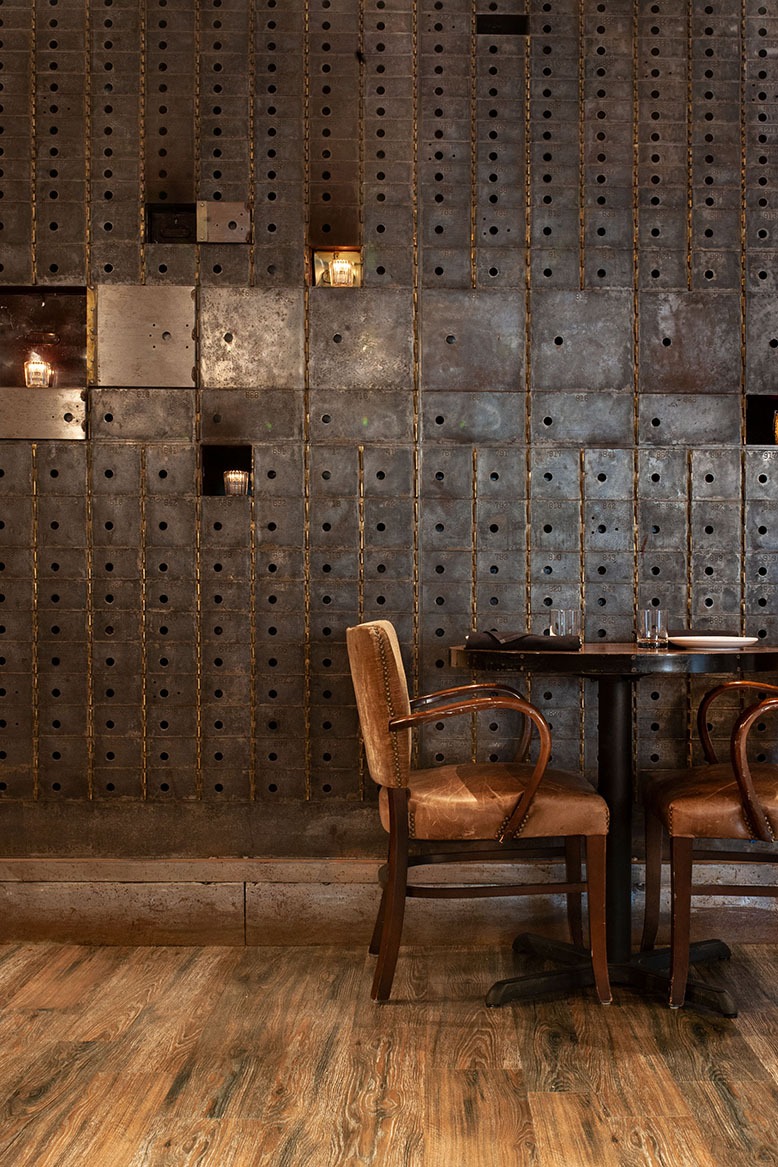
Candles set in a wall of former safe-deposit boxes illuminate a corner of Felina in Ridgewood. Photo courtesy of Edgardo Dander
These and other restored—or still endangered—bank buildings are the vestiges of a downtown building boom that swept across New Jersey in the early decades of the 20th century. Bankers built in downtown locations to garner foot traffic and to be closer to local businesses.
In those days, before federal deposit insurance, many depositors were reluctant to put their hard-earned money in the hands of local bankers. To counter this skepticism, banks commissioned top architects to construct jaw-dropping neoclassical structures reminiscent of Greek or Roman temples. With their soaring columns and brawny façades, the banks were often the most formidable structures on the block.
Inside the banks, marble counters, polished terrazzo floors, high ceilings, thick walls and seemingly impregnable vaults gave potential depositors an added sense of security. “They were built grand,” says Silver, “to present the idea that your money was going to be safe.”
Rikki Massand, chairperson of the Montgomery Township Landmarks Preservation Commission and a board member at the nonprofit advocacy group Preservation New Jersey (PNJ), points out that in small New Jersey towns, banks were often the largest and most imposing downtown buildings.
In recent decades, however, banks were built smaller, with utility in mind. Less space was needed for tellers and bank operations; drive-through lanes became essential. This generally meant a migration from the tighter confines of town centers.
In time, as downtown banks changed hands or were converted for other businesses, many of the original surfaces were hidden behind paneling or plasterboard. Original floors and tall windows were covered over. Dropped ceilings were installed in response to rising energy costs. Even classic exteriors were modernized.
These days, the tendency is toward restoration. That attitude could be accelerated by new state tax credits for historic redevelopment that make preservation more viable. “The numbers make sense now,” says Listokin.
Under New Jersey’s Historic Property Reinvestment Program, enacted in January 2021 as part of the state’s pandemic-era Economic Recovery Act, developers of properties listed as historic or in historic districts can be eligible for tax credits typically worth 40 percent of the total project cost, up to $4 million. This is in addition to existing 20 percent federal tax credits for historic redevelopment.
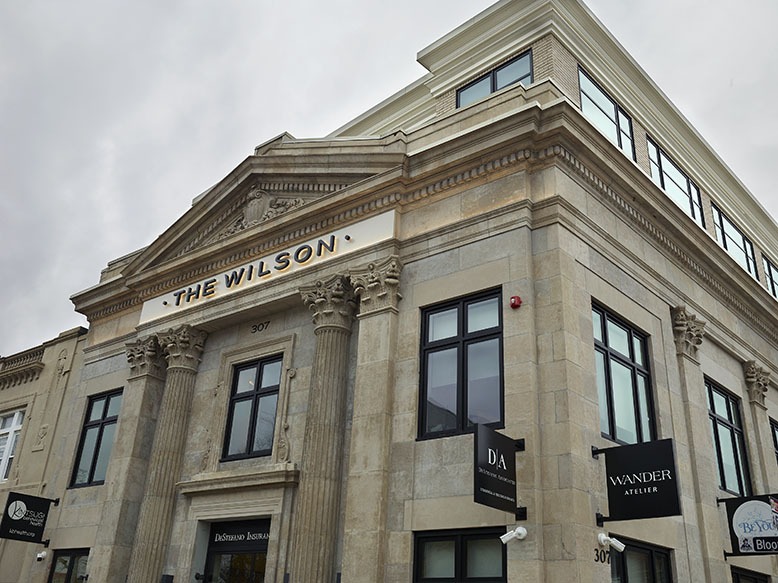
Silver named the renovated Caldwell National Bank building after his father. Photo by Chris Buck
Four miles west of Montclair, on Bloomfield Avenue in Caldwell, Silver has revived the former Caldwell National Bank building, now called the Wilson after the developer’s father, Lewis Wilson Silver. Once obscured beneath lime-green paint, the building’s Indiana limestone exterior has been restored to its original pinkish hue.
Inside the Wilson, Silver repurposed bank features as art pieces. At the side entry, an elaborate marble-faced clock from the teller floor greets visitors, and brass teller stanchions frame the tenant directory. Framed bank ephemera (a vintage check, boiler-room keys, bank-guard badges) hang along the entry hallway. Further on, a bank vault has been reimagined as a conference room. The numbers on reclaimed safe-deposit box doors double as suite numbers.
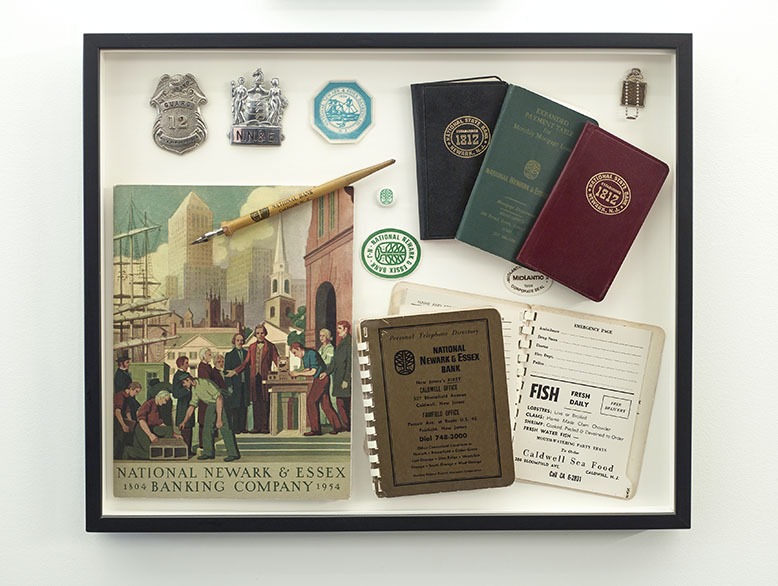
Framed bank ephemera greets visitors to the Wilson. Photo by Chris Buck
One block away, the old Citizens National Bank building, with sections dating to 1914, has been reborn as Grover House, named by Silver in tribute to Stephen Grover, first pastor of the First Presbyterian Church across the street and namesake of President Grover Cleveland, whose birthplace is a nearby state historic site.
Six fluted columns and preserved copper-and-brass framed Kalamein windows highlight the Grover House façade. Inside, salvaged stained-glass panels from the building’s original skylight are framed as art pieces on walls throughout the building. (“We saved them all,” says Silver.) A narrow vault lined with safe-deposit boxes serves as a corridor to the rear of the building. White marble service counters from the bank have been transformed into a conference-room table replete with Grover House notepads that resemble old deposit slips.
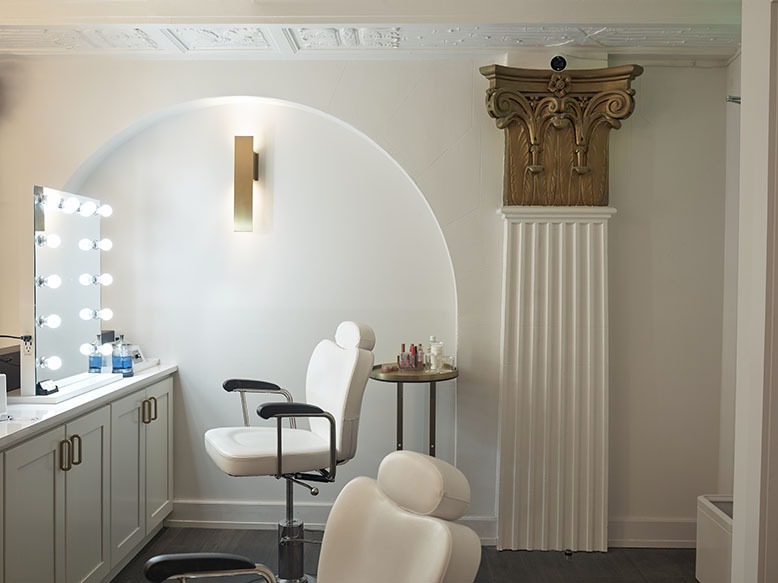
The gilded capital of an ornate column is among the preserved details inside Grover House’s David Chad Beauty Parlor. Photo by Chris Buck
The expansive David Chad Beauty Parlor occupies the cavernous, two-story teller floor of Grover House. Take the winding steps up to the balcony, and you are on eye level with the gilded tops of the Corinthian columns and the elaborate plasterwork of the coffered ceiling. Below, the original marble pillars and terrazzo floor remain in place.
Silver equips all of his projects with environmentally friendly electrical and plumbing fixtures and highly efficient HVAC systems. And all preserve as much of the original materials as feasible. Silver credits his team—builder Jack Finn, architect Paul Sionas and designer Rachel Grochowski—with the fulfillment of his vision.
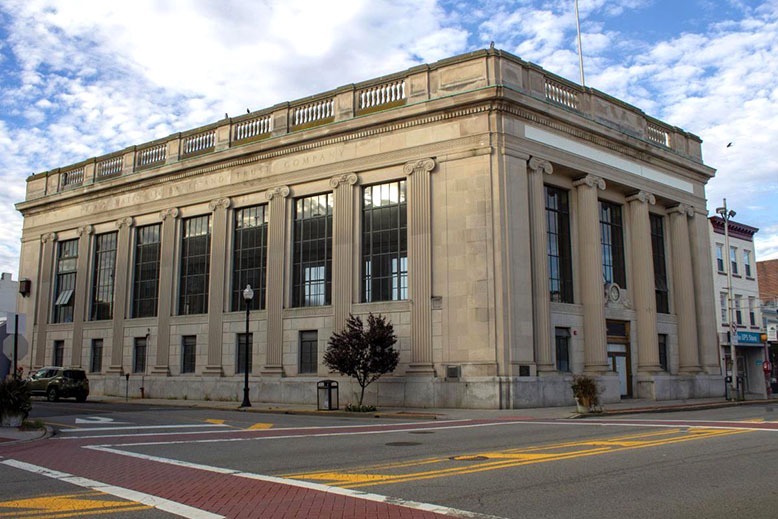
The former Citizens Bank building in Ridgewood has been transformed into Felina, a Landmark Hospitality restaurant and event space. Photo courtesy of Felina
Other developers have brought similar care and innovation to former downtown banks around the state. In late 2018, Plainfield-based Landmark Hospitality restored the former Citizens Bank in downtown Ridgewood. The front section of the stout old bank, where the tellers greeted customers, is now an elegant, high-ceilinged event space; the rear, where bank offices were located, has become Felina, a highly regarded restaurant operated by Landmark. The metal used for the restaurant’s bar was reclaimed from the old bank. Safe-deposit boxes remain in place on one wall of the restaurant, with candles illuminating some of the vacant boxes. The back of the vault door graces another wall.
Frank Cretella, cofounder of Landmark Hospitality and president of Landmark Developers, has since repurposed the former Plainfield Trust Company building in downtown Plainfield as another event space, dubbed Banq on Parq; it opened last summer. His newest project: rejuvenating the Trust Company of New Jersey building on Newark Avenue in downtown Jersey City.
Erected in 1928, the Trust Company building most recently housed a Capital One branch, but has been vacant for several years. Outside, a fleur-de-lis pattern is sculpted into the arches around six tall windows; delicate scrollwork frames the revolving entry door. Inside, a thick marble balustrade flanks the curving ramp to the teller floor. Above, five ornate chandeliers hang from the coffered ceiling above the mezzanine.
“They put these buildings on a pedestal to attract the very affluent,” says Cretella as he surveys the vast space.
Cretella plans to transform the bank into a restaurant and build an adjoining five-story, 80-room hotel above an existing rear parking lot. A new parking lot will be built below the hotel.
PNJ’s Massand cites the old First National Bank on Main Street in High Bridge as typical of the impressive bank buildings that once dominated some New Jersey downtowns. The Art Deco–style building, which dates to the early 1930s, was restored and reopened in 1997 as the home of Riverside Wines and Liquors. Intricately designed metalwork still surrounds the entrance; inside, the original teller counter, with its brass gates, serves as the checkout desk.
In South Jersey, a 1903 bank building in Riverside that sat vacant for some 10 years was reborn in 2015 as Maja-Flava Vape Den. Inside, the vaults are used as storage closets for the shop’s vaping products. In Woodstown, a couple turned an empty bank into a modern brewery. In historic downtown Pitman, a stone bank building dating to the first decade of the last century was reopened as Merryman’s Pub in May 2020. The building, originally the Pitman National Bank, had been vacant for 30 years and was slated for demolition. “There were plans on the table to make it a parking lot,” says bar manager George Del Duca.
Bank preservation is also in evidence at such Shore towns as Asbury Park, where a former downtown bank on Mattison Avenue is now home to pizza parlor Killer Pies, and in Ocean City, where developers transformed the 120-year-old First National Bank building into an outpost of Island Gypsy, a clothing boutique.
“It looks like you’re stepping back in time,” says Surf City–based Paul Maina, the main contractor on the Island Gypsy renovation. The bank’s exterior remains unchanged from the original, says Maina. Inside, designers gave the 1,700-square-foot retail space a sleek, modern look, but with respect for its history. The new windows preserve the arched shape of the originals, the ceiling remains 25 feet high, and the crown moldings are “still very much intact,” says Maina.
Maina confirms that such conversions present unique problems. “These old buildings, they fight you,” he says. “Every time you turn the corner, it’s a new adventure.”
In Morristown, an adaptive reuse of the National Iron Bank Building on South Street was less of a headache. When David Balsamini opened his Morristown Game Vault in the old bank in 2016, almost all he had to do was drill holes to run electrical wires from the basement. Then the former pharmacist from Basking Ridge filled every nook and cranny with more than 100 video games and pinball machines from his personal collection, including a game called Safe Cracker, whimsically installed in the safe-deposit vault.
More bank jobs are in the works. At deadline, the borough of Spring Lake was closing a deal to purchase the red-brick First National Bank building from Wells Fargo. Ownership of the building—the oldest in downtown Spring Lake—will allow the borough to “create a concessionaire’s license… and lease out the main floor as a restaurant,” says Mayor Jennifer Naughton. Additionally, three affordable-rate housing units will be built on the second floor.
All of this is music to the ears of preservationists. “I like to preserve these buildings and I like to give them new life,” says Landmark’s Cretella. “You put something in that’s a vibrant business, and you ensure the buildings are here for future generations.”
Ken Schlager is a former editor of New Jersey Monthly and a frequent contributor.
No one knows New Jersey like we do. Sign up for one of our free newsletters here. Want a print magazine mailed to you? Purchase an issue from our online store.
